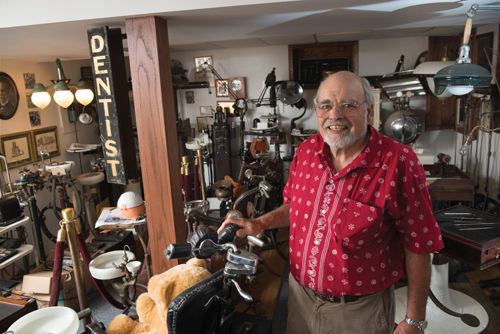Sam Wexler

See what Sam Wexler has been collecting
When Sam Wexler says he’s immersed in history, he’s not kidding.Years of collecting antique dental equipment and supplies going back to 1870 have transformed the Wexler family home into something of a gallery that captures the evolution of dentistry as well as the beauty of the hand-crafted materials from times gone by.
Born and raised in Chicago, Dr. Wexler was a newly minted dental graduate of the University of Illinois at Chicago College of Dentistry in 1964 when he went to work in 1970 at a practice in the Beverly neighborhood on the city’s south side. As part of his job, he visited closing dental practices to see what equipment could be bought or salvaged.
“That’s where it all started,” he said.
On his first expedition, he discovered an old dental “cluster light,” four cut-glass bulbs in a beautiful shade of green. He took the treasure home and mounted it in his family room.
Dr. Wexler had caught the bug, and as he read and studied old catalogues and visited old dental practices, he took in equipment – lots of it – starting with dental chairs, gorgeous wooden supply cabinets, antique tools, even an old X-ray machine. He soon found himself to be an expert on equipment and manufacturers going back to the late 1800s.
“I’ve got a whole house of this stuff,” he said with a laugh. But more than that, he has a passion for preserving the memories and artifacts that chronicle dentistry’s story.
Not unlike Henry Ford’s museum in Dearborn, MI, Dr. Wexler, 75, said the creation of a museum or center devoted to dental history would help to “save all this Americana.”
A walk through Dr. Wexler’s home in Richmond is like a walk back in time. An Archer dental cabinet, one of the very first cabinets made expressly for dentists, is in the French Room, along with an antique cuspidor. Two different, “magnificent” cabinets are in the dining room, one a mahogany “switchboard” cabinet that allowed for electricity and running water. Glass drawers highlight the other cabinet, “a beautiful piece,” that held trays and equipment for an early prosthodontist. A surprise find in that cabinet many years later was an old bottle that once contained dentistry’s earliest anesthesia, cocaine.
The basement houses the bulk of his collection of chairs. Early dentists used barber chairs, but the first manufacturers of dental chairs starting in the 1870s not only were ornate and beautifully crafted, they also included features to help dentists treat patients. Dr. Wexler has chairs with cranks, allowing for patients to be moved up and down, and chairs with hydraulics, from times when dentists stood over the patient; and children’s chairs. He also has porcelain equipment of all sorts (made after the importance of stopping the spread of bacteria was realized) and all manner of cuspidors and hand tools.
As he added to his collection, Dr. Wexler got his hands on old dental school programs and sent out fliers or tracked down dentists who graduated in 1920 or earlier, asking if they wanted to unload old equipment. “If we went on vacation somewhere near, I’d look these people up,” he said. “Half the fun was to meet these people.”
Nowadays, he said, “You can get a lot of things on Ebay, which has a section just for antique dentistry stuff.”
Dr. Wexler has put together more than 10 displays of historically accurate dental offices, including the Walgreens drugstore display with a turn-of-the-century dental office in the “Yesterday’s Main Street” exhibit at the Museum of Science of Industry in Chicago; a large display in the lobby of the Marquette University School of Dentistry building in Milwaukee; his alma mater, UIC; the National Museum of Dentistry in Baltimore; the A.T. Still University School of Osteopathic Medicine Dental School in Mesa, AZ.; and even the Hebrew University-Hadassah School of Dental Medicine in Jerusalem. He has donated pieces from his collection to round out the displays.
Though he’s an avid gardener and also likes to bike the trails around his home in his retirement, Dr. Wexler has begun to ponder what to do with his impressive collection.
“I’d like to keep it together,” he said, hoping that a museum or dental or medical organization could take the collection and showcase it in a display. “It’s part of our history.”
Ms. Sisk is a freelance journalist working in the Chicago metropolitan area.
View more photos of Dr. Wexler’s antique dental collection at on.cds.org/wexler.
